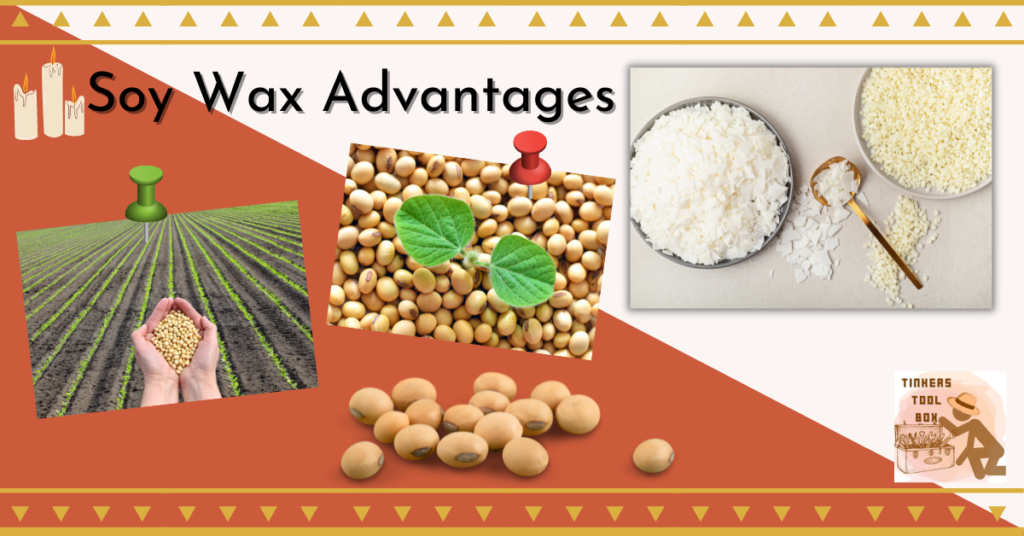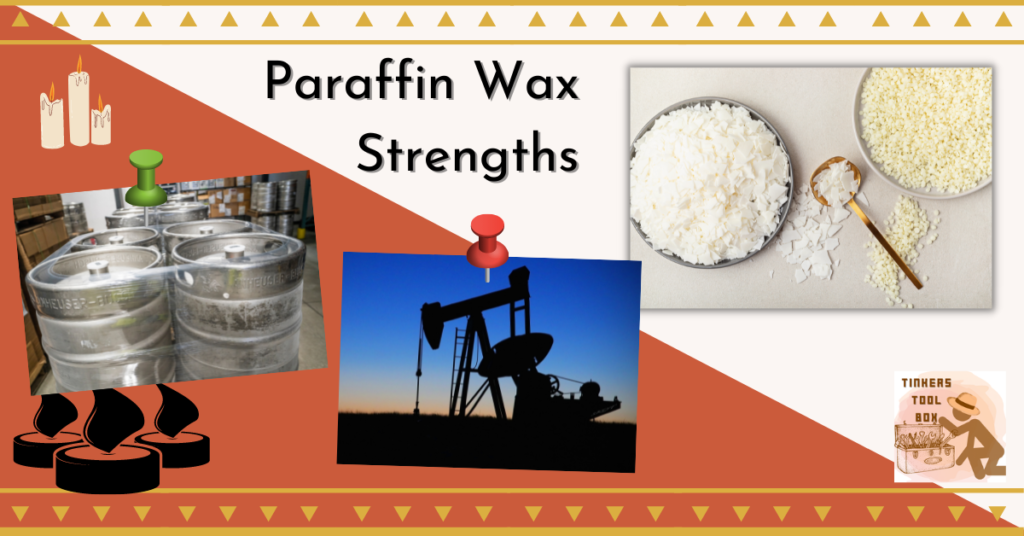There are many wax types, but soy and paraffin wax are the most popular choices for candle making. These are the common options for candle makers because they are budget-friendly, easy to work, and store. However, you may wonder what can be the better choice between the two, and I got the answer for you.
The answer depends on your need. Soy is better to use if you want a naturally made candle wax with little to no health concern that burns cleaner and longer. In contrast, choose paraffin wax if you want a product tested through time and has high workability for candle making.
If you like to work on candles but do not know what wax type you should use, your top choices may include paraffin and soy wax since they are the most affordable and readily available. However, you may want to consider other factors in choosing the better one between the two. This article will share information on a better choice between the two based on candle-making factors.
Soy Wax Advantages:A Better Choice For Candle Makers

Of the two, pure soy wax is a better choice for candle makers because it is a good healthy option releasing less to no toxic fumes. In addition, other soy wax traits make it a better choice listed below and some things to remember in choosing soy wax.
It Is Safer For The Health
Soy may be behind paraffin wax if you weigh in other wax characteristics. Still, it wins because you cannot do more candle making if exposed to harmful toxicants from paraffin released through fumes, which is the major reason soy wax is better.
Soy wax does not emit carcinogenic fumes that can trigger allergies, making it safer for candle-makers and the people in a space. It will also reduce harmful air contaminant that contributes to air pollution.
It Is Outsourced Naturally
Soy wax is safe because it is made from hydrogenated soybean oil. However, most soy wax candles are not made entirely of soy wax. They are made up of various waxes, including paraffin and beeswax, since they need a tiny quantity of treatment.
Although there is a difference when we call it organic and natural, soy wax is natural but not necessarily organic. The plant is naturally grown but can be treated to ensure good growth and production.
To ensure that you do candle making in the safest way possible, choose soy wax that is near pure quality but remember that even 100 percent soy wax candles require a tiny quantity of paraffin treatment.
However, this will not affect soy’s safety in general, given that there is only a little additive.
You also have to note that soy wax sometimes comes from genetically engineered soy plants you should check. It comes from a natural source and can be renewed with the proper means and techniques.
It is A Renewable and Biodegradable Resource
Renewable resources are a very important source of products since they ensure that sustainable harvesting of soy wax is maintained. Since soybeans are where wax is harvested and produced naturally, manufacturers can produce soy wax almost anywhere.
Soy waxes are manufactured from soybean oil; however, they also contain non-soy ingredients. The soybean oil is extracted using either a mechanical press or a solvent extraction method.
The hydrogenation process is the first stage in the production of soy wax. Soybean oil is treated with a hydrogen solution, which causes the oil to harden and form wax.
Every manufacturer has a unique procedure and must maintain their “recipes” a closely guarded secret, but the process always begins the same way.
At the same time, soy wax is also biodegradable and water-soluble, making accidental spills easier to clean the paraffin.
It Has Lower Melting Point and Less Soot
Soy wax is ideal for container candles since it has a lower melting point than other types of wax. Furthermore, we can add chemicals to soy wax to improve its melting point.
Soy wax candles do not produce any soot. As a result, decreasing soot levels can aid in preserving clean air. It is also softer than paraffin wax.
It is Easy To Measure
The wax’s format relates to its state when you receive it. Paraffin wax is generally shipped in a block, whereas soy wax is shipped in flakes. The flakes format of soy wax makes it easier to measure during candle making.
The difference in forms doesn’t alter much of the candle-making process, but soy wax flakes are easier to measure than paraffin.
When it comes to pillar-grade wax, breaking down the paraffin blocks can be painful and sometimes requires hulk-like power.
It Burns Longer
Soy wax burns longer because it has a lower melting point; hence it will burn cooler and allow you to enjoy the scent for much longer. However, there are arguable claims regarding this that you should know.
Paraffin Wax: A Practical Choice for Candle Makers

Although soy wax is a better choice between the two, paraffin has many strengths worth mentioning that can convince you to buy them.
It Has A Long History of Use
Paraffin wax is a petroleum-based substance that is soft and colorless. It is made from crude oil/fossil fuel that has been taken from the soil. Crude oil is a mixture of hydrocarbons created by decomposing plants and animals that lived thousands of years ago.
After being extracted, the oil is sent to refineries and refined into finished products such as lubricating oil. The lubricating oil refining process produces paraffin wax as a byproduct.
Paraffin is used to manufacture a variety of candles, such as containers, pillars, tealights, tapers, votives, and tarts. Paraffin wax is a solid at ambient temperature, although it melts around 37 °C.
It has a boiling point of more than 370 degrees Celsius. As a result, paraffin is one of the most preferred candle wax materials. It’s also the most affordable.
Paraffin wax is sometimes known as straight wax because it has no additives. Paraffin candles, on the other hand, can cause soot.
The solid particles generated by incomplete combustion of carbon-containing fuels, primarily petroleum-based fuels, are called soot, and since paraffin is made from petroleum, it emits some soot.
Petroleum-based paraffin waxes are made from crude oil, also known as fossil fuel, mined from the soil. On a molecular level, crude oil is a mixture of hydrocarbons formed by decomposing plants and animals that once lived underwater.
Crude oil is mined, transported to refineries, and refined into finished products like lubricating oil. Paraffin waxes are generated during the lubricating oil refining process.
It Is More Available in The Market
Sourcing wax entails all the steps in obtaining the wax or your art. In general, both wax types enjoy much support in the American market.
All major candle suppliers provide one or both of the main soy and paraffin wax kinds; however, finding soy wax outside the United States might be problematic.
Paraffin appears to be very easy to get by in most countries. Therefore, it receives a tiny nod in this quadrant’s availability area. A complete nod might be too presuming, so just a small nod will suffice.
It Can Be Made Into More Marketable Products
Without blending, soy wax is only good for container candles and melts. It has a lower melting point and stability issues; therefore, its offers are limited to melts and containers.
There’s more on that later. You can make every type of candle with paraffin wax, which has a long history in the candle industry.
The paraffin market is so diverse that you can get wax adapted to your unique needs, such as curving and curling wax for ornamental purposes.
Its Workability is High
Paraffin wax is derived from a separate source. Several techniques refine paraffin from slack wax, resulting in a final medium with essentially no polymorphic tendencies.
Besides a small amount of shrinking, most paraffin will keep the shape you want. Some formulae shrink so much that you must always pour a second layer to account for the bowl that forms on top, while others produce exactly what you want with few problems.
Compared to soywax, which is polymorphic, it misbehaves at the chemical layer. This means that when time and temperature change, soy wax develops crystals of varying sizes when time and temperature change, which is what you do while making a candle exactly: heat up, cool down, and wait.
Soy wax can be finicky. Crystal formation can make it difficult to discover a smooth top, crater-free result, necessitating extra care during manufacturing.
It’s not impossible to overcome soy wax characteristics like this, but it can be not very pleasant at times.
Overall, it’s a lot easier to make paraffin do what you want than to make soy do what you want, and it all comes down to the chemical history and makeup of the two waxes.
It Works Well With Colors
Many candle manufacturers take pride in the unusual hues seen in their products. Beginners may not realize it, but the hue of soy and paraffin wax varies.
The naked wax’s hue is already a milky white shade, and soy wax tends to silence the colors, exhibiting a range of pastels rather than more accurate colors of the dyes. See what happens when adding “soy wax white” to any color.
Paraffin has a lot less color, and colors put to it tend to take on more true shapes. What matters most to both waxes is what happens after the candle is made.
Soy wax tends to freeze and form little white crystals. When the wax is colored, the crystals stand out even more, giving the appearance of being exceedingly uneven and unattractive.
Paraffin does not cause frost and keeps the blend’s consistency long. Because of this, paraffin works far better than soy in terms of color.
It Has Longer Shelf Life
You can store both paraffin and soy for a long time. Although shelf life isn’t a key issue for most candle producers, it is still a useful comparison.
Over time, soy wax loses moisture and becomes brittle. The main effect is wicked size, but unpleasant characteristics such as uneven scent locking and erratic melt patterns also appear.
Soy wax is made through hydrogenation, which is also responsible for other goods we encounter, such as margarine and other oils used in baking.
Soy wax begins to show its life in good, stable storage after approximately a year and becomes slightly more difficult to tame.
Paraffin, on the other hand, is chemically stable and essentially inert. Most individuals have no problems with paraffin misbehaving within a year of manufacturing it, though there are always exceptions.
Paraffin will generally outperform soy in your workshop over all four seasons.
Paraffin or Soy Wax: Other Categories to Consider For The Better Choice
There are still things and factors to decide what wax type is better than the other. Here are some that will have your mind working.
Burn Time
Few research types compare soy vs. paraffin burn periods; burn length is misleading. Many say soy candles burn longer than paraffin, but these assertions are based on anecdotal evidence and lack scientific backing.
Soy is denser than paraffin and would experience more resistance traveling up through the wick than a paraffin equivalent.
Although the physical features of pure soy cannot be disputed, it is incorrect to suppose that soy wax and paraffin wax candles are designed similarly.
Choosing a wick that complements the wax blend’s thermal properties is the most crucial component of making a great candle that burns safely and effectively.
Great candles have a powerful aroma and pass an industrial safety test from top to bottom.
As a result, unlike soy wax candles, paraffin candles require wick designs that melt the wax while also regulating the temperature of the candle.
The last wick in those candles transmits heat to the wax at a sufficient rate to keep the candles safe and functional.
That’s a long way of stating you’ll use different wicks for each task to achieve the same results. Heat, controlled by the wick, ultimately determines the length of a burn.
Temperatures are produced differently by different wicks. Unless the candles are identical save for the wax, which is extremely rare, the density discussion is moot.
If they were, soy would presumably burn for longer, but a more comprehensive scientific approach to this hypothesis is required before it can be presented as fact.
When properly designed, similar volume soy and paraffin candles will burn for nearly the same period.
Scent Throw
The aroma is the only thing that most candles have going for them. No one wants a candle with no scent; therefore, your wax should be able to accommodate and maintain the fragrance design.
The secret to unlocking this performance is much more in the wick and container design than in the wax selection; however, wax plays a role in smell throw.
Fortunately, both Soy and paraffin work admirably in scent throw and retention. When all other factors are equal, paraffin candles often throw more aroma throughout a burn than their soy counterparts.
To figure out why you’ll need to understand density. When you compare the specific gravity of each wax, you’ll find that soy is usually higher than paraffin, implying that it’s heavier.
The heavier particles in soy wax require more energy to move; from a candle wick or an air current, paraffin infused with fragrance can travel further in a room than soy.
Again, other elements determine the literal fragrance throw, but paraffin has a better difficulty going around pound for pound.
This isn’t to say you can’t make or buy a great soy wax candle or that you can’t find a bad paraffin design, but when everything else is equal, paraffin wins in the chemistry aspect.
Popularity
It’s almost pointless to argue about how popular the soy wax candle market is compared to paraffin because candles’ parent industry is extremely saturated. Since the early 1990s, candles in the home have skyrocketed.
Compared to the 1980s, candles have evolved into a new market, with candles now having a role in home smell and home decor.
Soy wax and paraffin have the same potential for popularity, but candles that benefit the environment while humanitarian is a trend now, such as soy.
Today, more consumers are going for candle design rather than aroma, and paraffin wax can meet these needs. As a result, soy and paraffin are considered equal in this category.
If you are planning to level up your candle-making to a business, I wrote an article to guide you on profits you can get from this business idea.
Which is Which For A Candle Maker Like You
Soy and paraffin wax are good choices if it meets your needs. However, there are advantages over others that you should know to find the best answer. I recommend trying both to know what you want and what you need. It will be a trial-and-error battle with lots of reading on its benefits, but once you are knowledgeable about it, you will know what is best for your projects.















